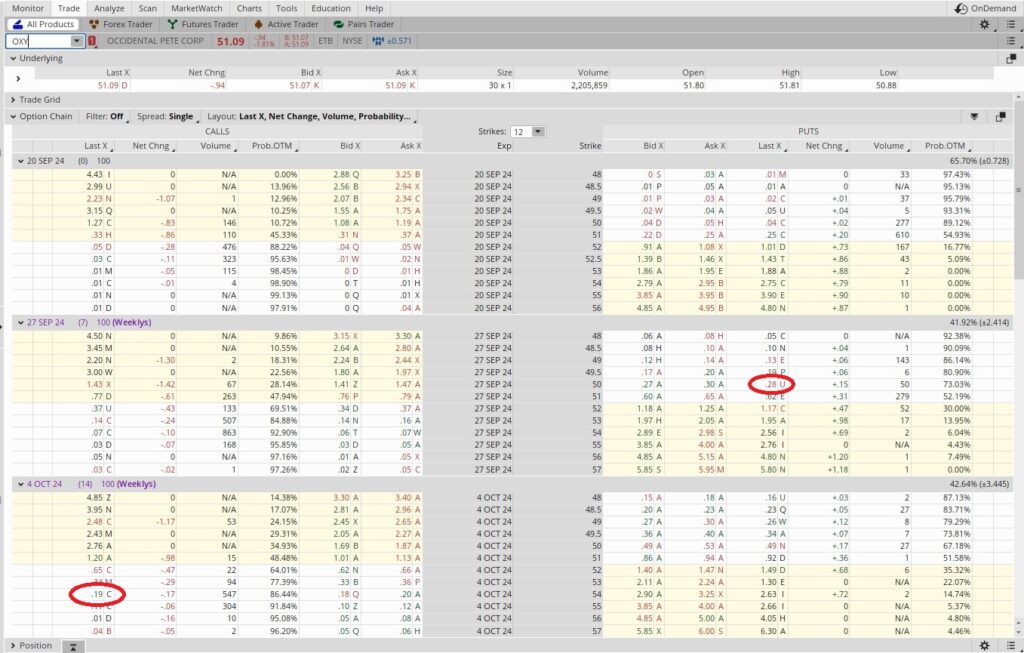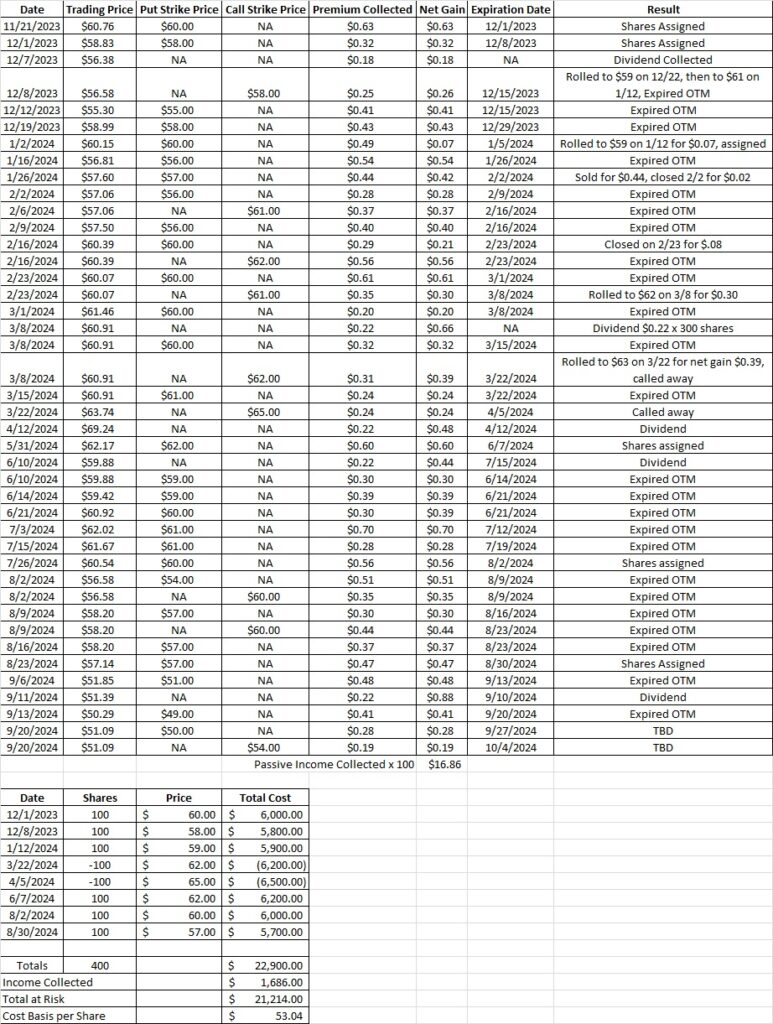Wheel Option Strategy
We’ve recently been using a wheel option strategy to generate passive income with options premium on OXY. Here’s a link to one of our recent posts about it. We’ve been aggressive with our puts on OXY because we wanted to get the $0.22 dividend this month. Now that OXY has gone ex-dividend and we’ve reduced our cost basis per share by $0.22, we’re ready to start trading OXY again.
Our current cost basis stands at $53.08 per share. OXY dropped along with the drop in oil prices over the past month. We’ve been able to minimize the impact of that drop with our options premium.
There appears to be support around the $50 level. Since we already have 400 shares of OXY in this portfolio we don’t need to be super aggressive on our puts to try to get more shares. We only have room for two more tranches of shares OXY in this portfolio. Since OXY hit support around $50 we’d like our put option contract to be at or below that level.
Wheel Option Explained
The wheel option strategy includes selling a put option on a company. We sell those put options repeatedly until we are assigned some shares. That could happen on the first put option contract we sell to open. More likely is that we sell a put option, collect the option premium, and then that put option expires out of the money. Then we sell another put and collect more option premium, and so on until we get assigned shares. By the time we’re assigned shares we’ve typically sold several puts on the company and have collected all that premium. Collecting that option premium several times means our cost basis on the company is usually lower than the strike price of the shares we purchase when our put option goes in the money and assigns shares to us. We’re essentially using put options create equity in the shares before we own them.
The second part of the wheel option strategy is to sell covered calls on the shares once we own them. We’ll sell our covered calls at or above the strike assignment price. Each time we sell a covered call we collect some options premium. That options premium reduces our cost basis per share of the company even if we do not sell our shares.
So we’re effectively making money from the put option premium when we buy the company, and we’re also making money from the call option premium when we sell the company. Even if we buy the shares and then sell the shares at the same strike price, we’ll still make money. That happens because we’re getting paid when we make the promise to buy the shares when we enter the put option contract. We’re also getting paid when we make the promise to sell the shares when we enter the call option contract. Those promises can add up to a healthy return. Let’s walk through an example.
Weekly Trade
OXY is currently trading at $51.09 and we own 400 shares. Our cost basis is $53.08 per share and we bought our last tranche at $57. One choice is to sell a call on that tranche at the $57 strike price. Another choice is to sell a call at $54, which is above our cost basis of $53.08. If OXY runs up through our call strike and we sell our shares at $54 still make money because we’ll be selling the shares for more than our cost basis and we’ll also be collecting the premium from selling the covered call. Since we have 400 shares, we’ll only sell one call option contract. That way we’ll still hold some shares in case we need to sell our call at $54.
We can see the $54 call with the 10/4 expiration date going for $0.19. We’ll sell that and reduce our cost basis on all 400 of our shares a few cents. Keep in mind the point of this wheel option strategy is not to sell our shares, it’s to reduce the cost basis of the shares we own by generating options premium. If we sell some of our shares on call options in the process we’re ok with that, but we want to hold some shares to ride OXY up.

We’re also going to generate some more option premium by selling a put at the $50 strike. We’ll do a one week long trade for that one, expiring 9/27. We can see the $50 put for the 9/27 expiration date is giving premium of $0.28. Since this trade lasts for one week, our time multiplier is 52 (because there are 52 weeks in a year). We’re risking $50 per share for that one week, and we’re earning $0.28 in premium to do it. So we divide that $0.28 in premium by our $50 strike price and we get 0.0056. Then we multiply that by our time multiplier and we get 0.291, or an annualized rate of return of 29.1%. We use this tool for that math. That’s a high enough return for us on the capital we’re risking, and we’re also bringing our cost basis down with the options premium.
Weekly Trade Recap
When we combine the options premium from this wheel option strategy we’re making $0.47 across both of those contracts. When we spread that out over the 400 shares we currently own we’re reducing our cost basis down to $53.04 per share.

